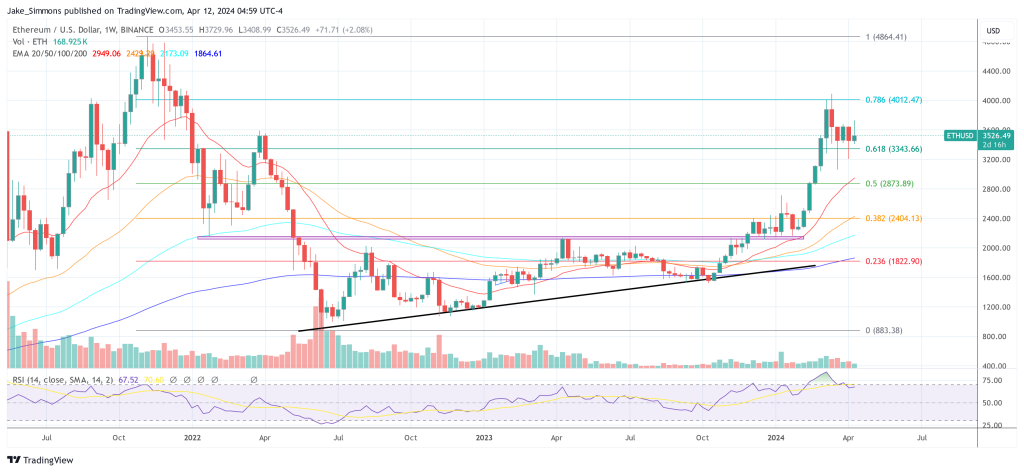A study conducted by Christine Kim at Galaxy Digital found that there are common misunderstandings among Ethereum users about the economic security of the Ethereum blockchain. In a survey, participants were asked to estimate the amount of ETH needed to secure the network. The results showed that many underestimated the potential risks of an attack.
Respondents to the poll displayed the following beliefs about Ethereum’s security:
- 44.9% believed that securing Ethereum requires 100% of all ETH staked, amounting to $110 billion, 31.4 million ETH.
20.4% thought 66.6% of staked ETH was sufficient, equivalent to $73.4 billion, 20.9 million ETH.
34.7% felt that only 33.3% of staked ETH, or $36.7 billion, 10.4 million ETH, was required for security.
How Vulnerable Is Ethereum?
Christine Kim clarified common misunderstandings about Ethereum’s Proof-of-Stake (PoS) system in her comprehensive response on X. She pointed out that “it is not necessary to control 100% of ETH for an attack. A smaller percentage, specifically 33%, can cause disruptions in finality; 50% can prolong chain splits; and 66% is sufficient to double-spend Ethereum.”
“She explained, ‘The network’s capacity to impose penalties on stakers by destroying a significant portion of their deposited value is crucial for security. The more severe the assault, the greater the potential loss for stakers. It’s vital to grasp the true implications of this situation (pun intended).'”
The Ethereum Foundation provides additional details about these vulnerabilities in a published article. According to Kim’s reference, an attacker needing 33% of the total staked ether can significantly increase the likelihood of successful attacks mentioned earlier. This threshold represents a crucial benchmark for potential attackers since having more than this amount enables them to hinder the Ethereum chain from finalizing without requiring extensive control over other validators’ actions.
When approximately one-third (34%) of the overall stake is at risk for assaults, the article described a potential situation called “double finality.” In this scenario, an attacker could attempt to manipulate the validation of two conflicting blockchain branches concurrently. This type of attack requires extensive planning and influence over message sequencing within the network, increasing danger due to the possibility of penalties resulting in the loss of the attacker’s entire staked investment.
Staking at higher proportions, like 50% and 66%, can lead to more serious disruptions. According to the foundation’s article, an attacker with this level of control could manipulate the fork choice algorithm above 50% of the total stake. Consequently, they might suppress certain transactions, carry out short-term reorganizations, and prioritize their own transactions for maximum profit.
The defense against these risks involves the “inactivity drain,” a feature that progressively decreases the deposited ether of idle or harmful validators over time, and the social aspect of agreement among Ethereum users as to which chain to adhere to in case of a fork.
The disclosures emphasize the significance of keeping communities informed and applying technical protections to preserve the safety and authenticity of the Ethereum network. They demonstrate that while Ethereum’s Proof-of-Stake system boasts numerous security benefits, it also necessitates constant surveillance and preparedness to thwart potential assaults.
3 Trends In ETH Staking
With the ongoing development of Ethereum staking, some notable patterns have arisen, transforming the way participants engage and derive value from staking activities.
Tom Wan, researcher at 21.co, highlighted these in a recent post on X:
- Increase in Re-staking Popularity: Since 2024, there has been a significant shift towards re-staking in the Ethereum ecosystem. Re-staking contributions have grown from 10% to 60% of the total staked ETH. Eigenlayer, in particular, has risen to prominence as the second-largest DeFi protocol on Ethereum, holding a $15 billion Total Value Locked (TVL), which represents 13% of all staked ETH.
Decline in Lido’s Market Share: The rise of liquid restaking protocols has noticeably impacted Lido’s dominance in the Ethereum staking market. Lido’s share has fallen below 30%, influenced by the growth of new platforms like Etherfi, which has become the second-largest withdrawer of stETH since 2024, totaling withdrawals of 108k stETH.
Centralized Exchange (CEX) Staking Decline: The dominance of centralized exchanges in ETH staking has seen a downturn, decreasing from 29.7% to 25.8% since 2024. Kiln Finance recently surpassed Binance to become the third-largest ETH staking entity. Ether.fi is also gaining ground and is positioned to further challenge Binance’s former dominance in the near future.
At press time, ETH traded at $3,526.

Read More
- USD ZAR PREDICTION
- SOL PREDICTION. SOL cryptocurrency
- BTC PREDICTION. BTC cryptocurrency
- EUR ILS PREDICTION
- CKB PREDICTION. CKB cryptocurrency
- LUNC PREDICTION. LUNC cryptocurrency
- TROY PREDICTION. TROY cryptocurrency
- REF PREDICTION. REF cryptocurrency
- LOVELY PREDICTION. LOVELY cryptocurrency
- WELL PREDICTION. WELL cryptocurrency
2024-04-12 12:41